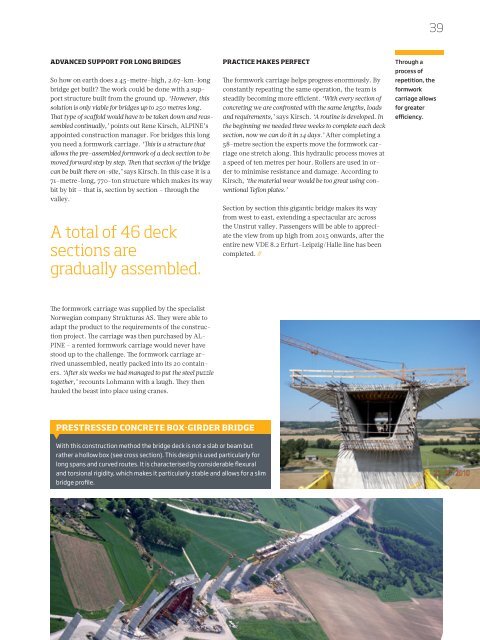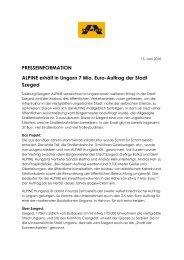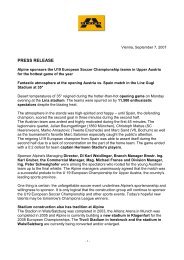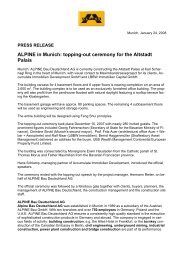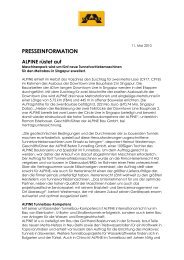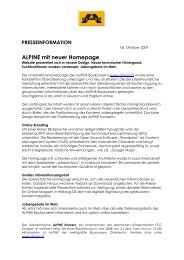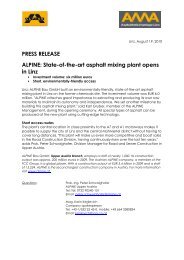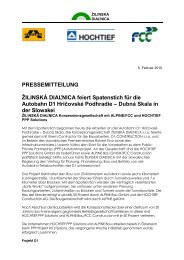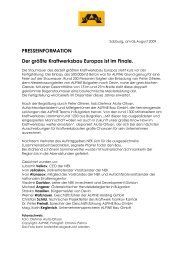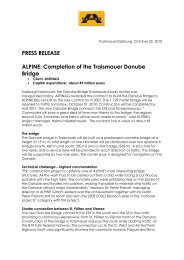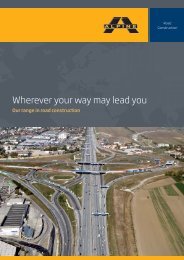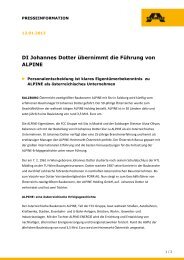DAM IMPRESSIVE
DAM IMPRESSIVE
DAM IMPRESSIVE
Create successful ePaper yourself
Turn your PDF publications into a flip-book with our unique Google optimized e-Paper software.
adVanCed SuPPoRt foR long bRidgeS<br />
So how on earth does a 45-metre-high, 2.67-km-long<br />
bridge get built? The work could be done with a support<br />
structure built from the ground up. ‘However, this<br />
solution is only viable for bridges up to 250 metres long.<br />
That type of scaffold would have to be taken down and reassembled<br />
continually,’ points out Rene Kirsch, ALPINE’s<br />
appointed construction manager. For bridges this long<br />
you need a formwork carriage. ‘This is a structure that<br />
allows the pre-assembled formwork of a deck section to be<br />
moved forward step by step. Then that section of the bridge<br />
can be built there on-site,’ says Kirsch. In this case it is a<br />
71-metre-long, 770-ton structure which makes its way<br />
bit by bit – that is, section by section – through the<br />
valley.<br />
a total of 46 deck<br />
sections are<br />
gradually assembled.<br />
The formwork carriage was supplied by the specialist<br />
Norwegian company Strukturas AS. They were able to<br />
adapt the product to the requirements of the construction<br />
project. The carriage was then purchased by AL-<br />
PINE – a rented formwork carriage would never have<br />
stood up to the challenge. The formwork carriage arrived<br />
unassembled, neatly packed into its 20 containers.<br />
‘After six weeks we had managed to put the steel puzzle<br />
together,’ recounts Lohmann with a laugh. They then<br />
hauled the beast into place using cranes.<br />
PReStReSSed ConCRete boX-giRdeR bRidge<br />
PRaCtiCe makeS PeRfeCt<br />
With this construction method the bridge deck is not a slab or beam but<br />
rather a hollow box (see cross section). This design is used particularly for<br />
long spans and curved routes. It is characterised by considerable flexural<br />
and torsional rigidity, which makes it particularly stable and allows for a slim<br />
bridge profile.<br />
The formwork carriage helps progress enormously. By<br />
constantly repeating the same operation, the team is<br />
steadily becoming more efficient. ‘With every section of<br />
concreting we are confronted with the same lengths, loads<br />
and requirements,’ says Kirsch. ‘A routine is developed. In<br />
the beginning we needed three weeks to complete each deck<br />
section, now we can do it in 14 days.’ After completing a<br />
58-metre section the experts move the formwork carriage<br />
one stretch along. This hydraulic process moves at<br />
a speed of ten metres per hour. Rollers are used in order<br />
to minimise resistance and damage. According to<br />
Kirsch, ‘the material wear would be too great using conventional<br />
Teflon plates.’<br />
Section by section this gigantic bridge makes its way<br />
from west to east, extending a spectacular arc across<br />
the Unstrut valley. Passengers will be able to appreciate<br />
the view from up high from 2015 onwards, after the<br />
entire new VDE 8.2 Erfurt-Leipzig/Halle line has been<br />
completed. //<br />
39<br />
Through a<br />
process of<br />
repetition, the<br />
formwork<br />
carriage allows<br />
for greater<br />
efficiency.


